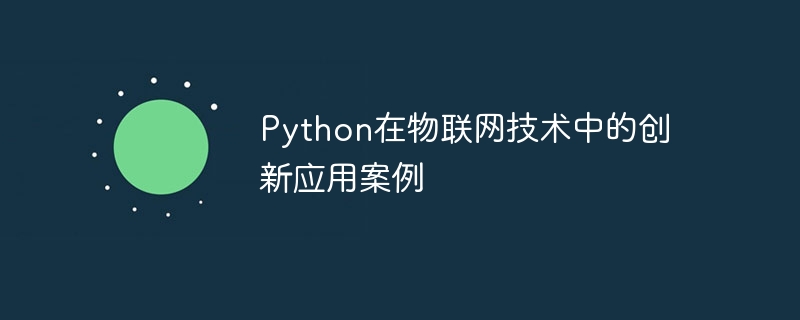

Innovative application cases of Python in Internet of Things technology
Introduction:
The development of Internet of Things technology is changing the way we live and work. As a simple, easy-to-learn and powerful programming language, Python is widely used in the field of Internet of Things. This article will introduce innovative application cases of Python in Internet of Things technology and provide corresponding code examples to facilitate readers' understanding and practice.
Case 1: Real-time monitoring and analysis of sensor data
In the Internet of Things system, sensors are important devices for obtaining environmental data. By using Python, we can easily monitor and analyze sensor data in real time. The following code example shows how to use Python and the MQTT protocol to obtain sensor data and analyze it:
import paho.mqtt.client as mqtt
# MQTT回调函数,当接收到传感器数据时触发
def on_message(client, userdata, msg):
print("Received data: " + msg.payload.decode())
# 设置MQTT客户端
client = mqtt.Client()
client.on_message = on_message
# 连接MQTT代理并订阅传感器数据主题
client.connect("mqtt_broker_ip", "mqtt_broker_port")
client.subscribe("sensor_data_topic")
# 循环监听MQTT消息
client.loop_forever()In the above code example, we use the Paho MQTT library to connect to the MQTT broker and obtain sensor data through the callback function. Readers can fill in the IP address and port number of the MQTT broker as well as the subject of the sensor data according to the actual situation. In this way, we can obtain and analyze sensor data in real time to provide support for subsequent decision-making and control.
Case 2: Smart Home Control System
Python is also widely used in the field of smart homes. The following code example shows how to use Python and the Flask framework to build a simple smart home control system:
from flask import Flask, request
app = Flask(__name__)
# 灯控制接口
@app.route('/light', methods=['POST'])
def control_light():
status = request.form.get('status')
# 在这里执行灯的控制逻辑
if status == 'on':
return 'Light is turned on'
elif status == 'off':
return 'Light is turned off'
else:
return 'Invalid status'
if __name__ == '__main__':
app.run()In the above code example, we use the Flask framework to build a simple web application, controlled through POST requests The light switch status. In practical applications, we can connect this interface with IoT devices and realize automated control of smart homes by sending control instructions.
Case 3: Data Visualization and Analysis
The massive data generated in the Internet of Things system requires effective visualization and analysis. Python provides many powerful data processing and visualization libraries, such as NumPy, Pandas and Matplotlib, which can help us with data processing, analysis and visualization. The following code example shows how to use Python for data visualization and analysis:
import numpy as np
import pandas as pd
import matplotlib.pyplot as plt
# 生成随机传感器数据
sensor_data = np.random.randn(1000)
# 使用Pandas将数据转换为数据帧
df = pd.DataFrame({'sensor_data': sensor_data})
# 数据可视化
df['sensor_data'].plot()
plt.xlabel('Time')
plt.ylabel('Sensor Data')
plt.show()
# 数据分析
mean = df['sensor_data'].mean()
std = df['sensor_data'].std()
print('Mean:', mean)
print('Standard Deviation:', std)In the above code example, we first generated random sensor data and used Pandas to convert the data into a data frame. Then, we used the Matplotlib library for data visualization and drew a time series diagram of the sensor data. Finally, we calculated the mean and standard deviation of the sensor data using the NumPy and Pandas libraries. In this way, we can get a clearer understanding of trends and statistical characteristics of sensor data.
Conclusion:
This article introduces innovative application cases of Python in Internet of Things technology and provides corresponding code examples. Readers can further study these cases according to their own needs and actual conditions, and apply Python to the development of IoT systems. I believe that through continuous innovation and practice, Python will have more applications and breakthroughs in the field of Internet of Things.
The above is the detailed content of Innovative application cases of Python in Internet of Things technology. For more information, please follow other related articles on the PHP Chinese website!




